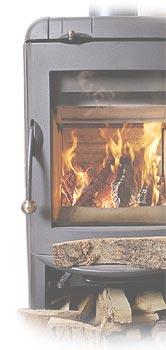Controlling Air Quality from Wood Stoves
As energy costs continue to be higher for Alaskans than elsewhere in the country, woodstoves have become more popular as a secondary heating source and in some areas, as a primary source of heat.
The smoke from the incomplete combustion of wood in woodstoves and fireplaces contains a complex mixture of gas and particles (over 100 different chemical compounds), many of which are harmful and potentially carcinogenic to health and the environment. Of particular concern are fine particulate matter (PM 2.5- particles smaller than 2.5 micrometers including black carbon, which can affect both lungs and heart), nitrogen oxides, sulfur oxides, carbon monoxide, volatile organic compounds (VOC's), dioxins, furans and benzene.
In the winter, people can spend most of their time in doors and thus are affected by the smoke. Inversions outside can also occur when temperatures drop, trapping toxic fumes near the ground where people are exposed. Smoke produced from wood stoves and fireplaces is a public health risk.
Health risks from particle pollution exposure includes:
- increased respiratory symptoms; irritation of the airways, coughing, or difficulty breathing;
- decreased lung function;
- aggravated asthma;
- development of chronic bronchitis;
- irregular heartbeat;
- nonfatal heart attacks;
- premature death in people with heart or lung disease.
People with heart or lung disease, the elderly and young are particularly susceptible to pollution exposure from wood stoves but even healthy people may experience temporary symptoms from exposure to elevated levels of particle pollution.
EPA issued standards of performance for new wood stoves in 1988 (7.5 grams of smoke per hour (g/h) for non-catalytic stoves and 4.1 g/h for catalytic) and is about to update these standards in 2015 (2 to 2.5 g/h for both catalytic and non-catalytic stoves) for new stoves produced after 2015. It is estimated that PM 2.5 and VOC emissions from wood stoves covered by the rules will drop almost 70%. Carbon monoxide emissions will be reduced by about 62%. By 2020, even cleaner models of wood stoves will be manufactured.
To protect your health and the health of your loved ones, there are key steps you can take.
- Make sure your wood stove is EPA-certified.
- Make sure your wood stove is properly installed.
- Choose proper fuel- Only dry, untreated wood is acceptable to burn
- never use wet or freshly cut wood
- Season your wood for 6 months to a year or so depending on wood used.
- use properly sized wood depending on your stove size
- split wood to a maximum thickness of 4-6 inches.
- never burn household waste
- Use proper burning techniques
- start with a small fire using kindling, damper open
- carefully control airflow
- get fire hot enough to burn off gases being produced.
- Maintain stove, checking for leaks and have chimney cleaned annually.
- Reduce the amount of firewood used by making your house more energy efficient
Learn more about
- Chainsaw Safety
- Handling and Hauling Wood Safely
- Proper installation of stoves and chimneys
- Drying and Storing Firewood Safely
- Health Concerns with Wood Heating
Also see:
- On-line heat cost calculator
Compare the costs of different fuels - Home Heating applications
Learn how to heat your home most effectively - Wood availability by region
Learn what species are available to you, and what they may cost

